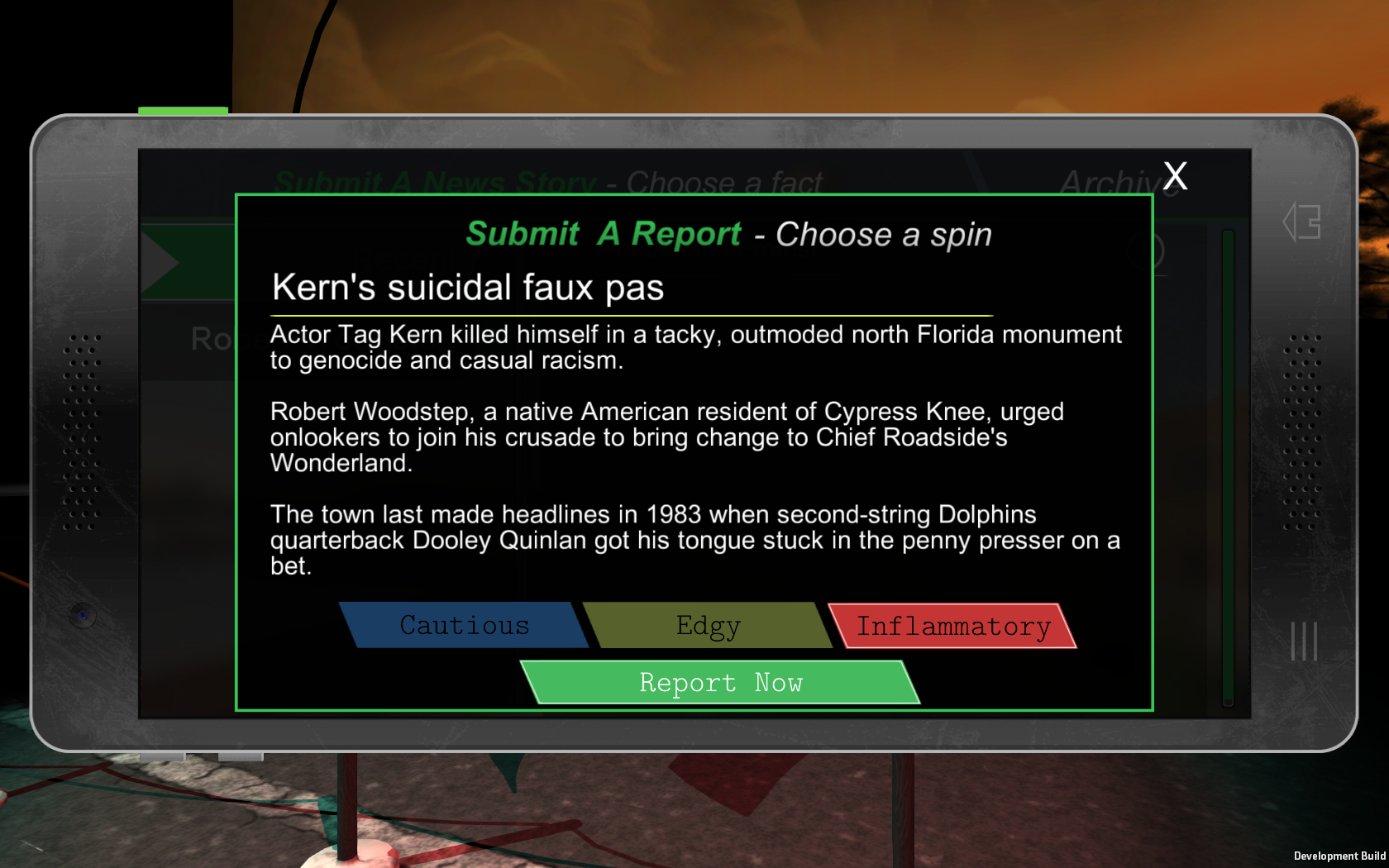
No one makes you sort through inventory puzzles to make the chandelier fall during The Phantom of the Opera. You don’t have test your key-tapping skills to get to the helicopter scene in Miss Saigon. You’re not expected to defeat quick-time events to learn Willy Loman’s fate in Death of a Salesman. These would just be distractions from the real experience.
Knee Deep is more interactive than these remarkable shows, yet our game is inspired from such an intense focus on characters. Set in the backwater Florida town of Cypress Knee, the game has you investigating a curious suicide as three characters: gossip blogger Romana Teague, local reporter Jack Bellet, and private investigator K.C. Gaddis. Decisions you make in conversations, mini-games, and plot-specific special events shape these characters and how the people of the town treat you.
Your blog posts, news articles, and investigative reports can draw a lot of hits or alienate people who might prove valuable assets in the long run. For example, in this scene Romana chats with Robert Woodstep, an activist protesting the political incorrectness of Chief Roadside’s Wonderland. As the videos below demonstrate, the spin you put on the blog post Romana writes after the exchange with Woodstep has a consequence: write favorably about his cause and a bigger protest forms, but you can also stifle his effort by mocking him.
I’ve written a broad script that affords choice, but characters have marks they’re going to hit. Our swamp noir adventure has a narrative framework that doesn’t stifle choice; on the contrary, it makes decisions all the more meaningful for the affect they have on the characters. We embraced this idea early in the game’s development. While sacrificing a certain amount of player agency, this approach focuses the experience around story. Simply put, we’re counting on you to trust us to show you a good time.
In the first iteration, Act 1: Wonderland didn’t have just one ending. We built three finale sequences, one for each of our main characters. You would select a character for the finale after bouncing among viewpoints during the act. That seemed good in theory, giving the appearance of variety and extra replayability. But when it came down to it, it felt like two of these endings were only slight variations on the first – something on which players might rightly call us out. Ultimately, we opted to go with a single finale sequence, though you now get to make a vital choice that reverberates through later acts.
Knee Deep is not a free-roaming, open-world, pixel-hunting adventure; instead, we embrace the spectacle of stagecraft, taking you from one scene to the next making choices that affect the characters. In an effort to distill our own brand of narrative, we carefully considered the various approaches to delivering our story. Would we try a narrative-through-mechanics style action game, a head-scratching puzzle game, a relationship management sim, or something completely different? Some of my favorite adventure games incorporate such elements–The Secret of Monkey Island, Myst, Memoria, and even creepy open-world adventure Sunless Sea—but I wanted to put more focus on the character narrative when it came to Knee Deep.
We want Knee Deep players to find the fun in experimenting with their character’s personality and, through that exploration of the narrative space, see what effects they have on how others react to them. It’s about characters who are (sometimes unwitting) pawns in the byzantine schemes of small-town Florida politicians, Hollywood honchos, and sinister cult churches. The big plot points may not change, but you’re making choices that will yield significant changes to the narrative – from small nuances to big-picture consequences. Some of that cause-and-effect won’t play out until Act 3…

